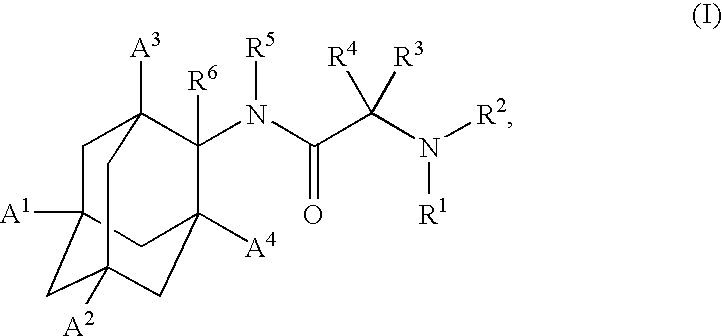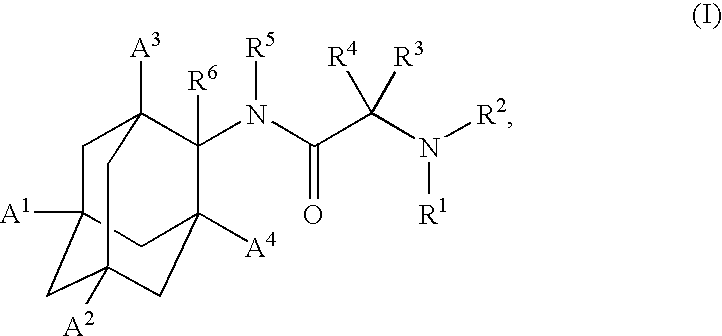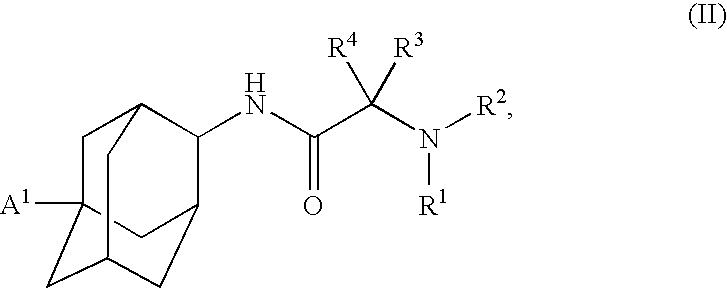Inhibitors of the 11-beta-hydroxysteroid dehydrogenase Type 1 enzyme
a technology of steroid dehydrogenase and enzyme, which is applied in the direction of biocide, drug composition, metabolic disorder, etc., can solve the problems of increased and premature morbidity and mortality, poor compliance, and insufficient compensatory increase to overcome insulin resistan
- Summary
- Abstract
- Description
- Claims
- Application Information
AI Technical Summary
Benefits of technology
Problems solved by technology
Method used
Image
Examples
example 1
N-[(Z)-5-hydroxy-2-adamantyl]-2-{4-[5-(trifluoromethyl)pyridin-2-yl]piperazin-1-yl}acetamide
example 1a
Acetic acid 2-oxo-adamantan-5-yl ester
[0580] A solution of 5-hydroxy-2-adamantanone (2.6 g, 15.66 mmoles) in dichloromethane (DCM) (50 mL) was treated with dimethylaminopyridine (DMAP) (2.1 g, 17 mmoles) and acetic anhydride (2.3 mL, 23 mmoles) and stirred overnight at 50° C. The solvent was removed under reduced pressure and the residue was partitioned between water and ethyl acetate. The aqueous layer was extracted twice with ethyl acetate. Combined organic extracts were washed with water, dried (MgSO4) and filtered. The filtrate was concentrated under reduced pressure to provide the title compound as an off-white solid (3.124 g, 95.8%).
example 1b
E- and Z-acetic acid 2-amino-adamantan-5-yl ester
[0581] A solution of acetic acid 2-oxo-adamantan-5-yl ester (3.124 g, 15 mmoles), from Example 1A, and 4 Å molecular seives (1 g) in methanolic ammonia (7N, 50 mL) was stirred overnight at room temperature. The mixture was cooled in an ice bath, treated portionwise with sodium borohydride (2.27 g, 60 mmoles) and stirred at room temperature for 2 hours. The suspension was filtered and concentrated under reduced pressure. The residue was taken into DCM (50 mL), acidified with 1N HCl to pH=3 and the layers separated. The aqueous layer was basified with 2N NaOH to pH=12 and extracted three times with 4:1 tetrahydrofuran:dichloromethane (THF:DCM). The combined organic extracts were dried (MgSO4) and filtered. The filtrate was concentrated under reduced pressure to provide the title compound as a white solid (1.82 g, 58%).
PUM
| Property | Measurement | Unit |
|---|---|---|
| Electrical resistance | aaaaa | aaaaa |
Abstract
Description
Claims
Application Information
 Login to View More
Login to View More - R&D
- Intellectual Property
- Life Sciences
- Materials
- Tech Scout
- Unparalleled Data Quality
- Higher Quality Content
- 60% Fewer Hallucinations
Browse by: Latest US Patents, China's latest patents, Technical Efficacy Thesaurus, Application Domain, Technology Topic, Popular Technical Reports.
© 2025 PatSnap. All rights reserved.Legal|Privacy policy|Modern Slavery Act Transparency Statement|Sitemap|About US| Contact US: help@patsnap.com



